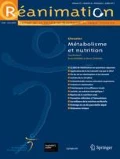Résumé
La loi du 2 février 2016, dite « loi Claeys-Leonetti » crée de nouveaux droits pour les patients en fin de vie. Sans légaliser l’euthanasie ou le suicide assisté, le texte instaure un droit à une sédation « profonde et continue » jusqu’au décès dans certaines conditions et rend contraignantes les « directives anticipées ». La loi prévoit aussi un renforcement des soins palliatifs (SP), en particulier favorisant le développement d’une approche intégrant les SP aux soins curatifs. L’hydratation et la nutrition artificielle, désormais « traitements » et non plus « soins », peuvent être arrêtées après une décision d’arrêt des thérapeutiques actives. Ainsi, après la loi Leonetti de 2005, ce nouveau texte apporte des éléments nouveaux et pertinents pour la pratique de la réanimation.
Abstract
A new law developed by two members of the French parliament, A Claeys and J Leonetti, and passed on February 2, 2016, extends patients’ rights at the end of life. Although both euthanasia and assisted suicide remain illegal, “deep and continuous sedation until death” is allowed under certain circumstances. Furthermore, the new law encourages all individuals to make advance directives, which healthcare providers are now required to follow. Palliative care is given a greater role, as the law mandates an integrated approach that dovetails palliative care to curative care. Hydration and artificial nutrition are now classified as treatments, instead of supportive care, and can therefore be withdrawn from patients with treatment-limitation decisions. Thus, compared to the 2005 Leonetti law, this new piece of legislation has practical implications for patients and intensivists.
Références
2015) http://www.elysee.fr/assets/Uploads/Rapport-et-propositionde- loi-creant-de-nouveaux-droits-en-faveur-des-malades-et-des-personnes- en-fin-de-vie.pdf
2016) https://www.legifrance.gouv.fr/affichTexte.do;jsessionid= 71133BF382C228275DC8D898B3C26748.tpdila10v_2?cidTexte= JORFTEXT000031970253&categorieLien=id
Aubry R, Morin L (2015) Quel avenir pour la politique de développement des soins palliatifs en France ? Med Palliat 14:129–33
Ferrand E, Robert R, Ingrand P, et al (2001) Withholding and withdrawal of life support in intensive-care units in France: a prospective survey. French LATAREA Group. Lancet 357:9–14
Ferrand E, Marty J, French LG (2006) Prehospital withholding and withdrawal of life-sustaining treatments. The French LATASAMU survey. Intensive Care Med 32:1498–505
Temel JS, Greer JA, Muzikansky A, et al (2010) Early palliative care for patients with metastatic non-small-cell lung cancer. N Engl J Med 363:733–42
Pennec S, Monnier A, Pontone S (2012) Les décisions médicales en fin de vie en France. Population et Sociétés no 494: https:// www.ined.fr/fichier/s_rubrique/19162/19494.fr.pdf
Kring DL (2007) The Patient Self-determination Act: has it reached the end of its life? JONAS Healthc Law Ethics Regul 9:125–31
Conseil national de l’Europe (2012) http://assembly.coe.int/nw/ xml/XRef/Xref-XML2HTML FR.asp?fileid=18064&lang=FR
Bourquin V, Lefuel P, Cassagne B, et al (2011) Advance directives application in a chronic dialysis service unit: instructions. Rev Med Suisse 7:2308–11
Rigaud JP, Meunier-Beillard N, Aubry R, et al (2016) Le médecin réanimateur: un consultant extérieur pour un choix éclairé du patient et de ses proches ? Réanimation 25:367-71
Conseil national de l’ordre des médecins (2015) https://www. conseil-national.medecin.fr/sites/default/files/cp_rappel_position_ fin_de_vie.pdf
Oriot D, Lassaunière JM (2008) Physiopathologie et sémiologie de l’arrêt de nutrition et de l’hydratation. Med Palliat 7:310–4
Author information
Authors and Affiliations
Consortia
Corresponding author
Rights and permissions
About this article
Cite this article
Boyer, A., Eon, B., Quentin, B. et al. Que change la Loi Claeys-Leonetti pour les réanimateurs ?. Réanimation 25, 419–425 (2016). https://doi.org/10.1007/s13546-016-1202-7
Received:
Accepted:
Published:
Issue Date:
DOI: https://doi.org/10.1007/s13546-016-1202-7

